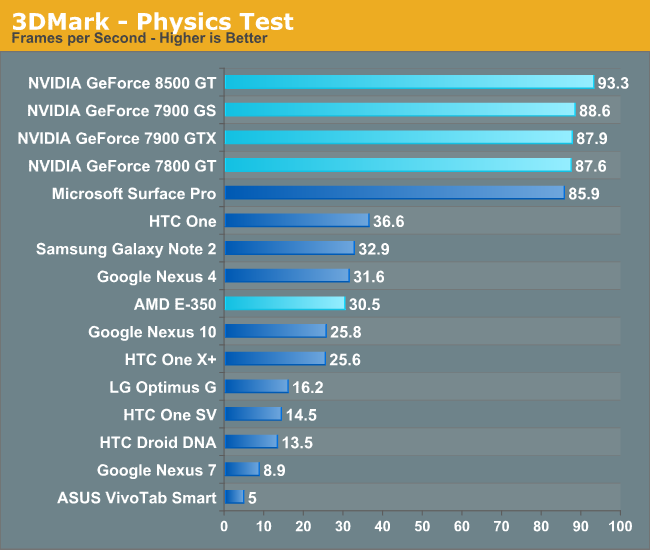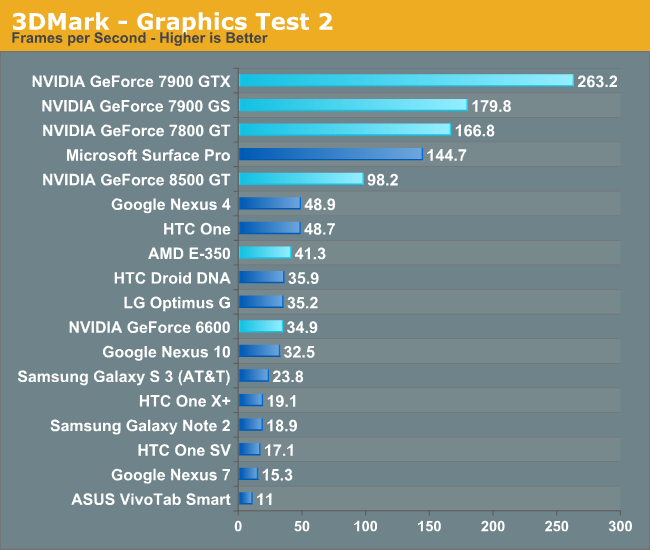The Great Equalizer 3: How Fast is Your Smartphone/Tablet in PC GPU Terms
by Anand Lal Shimpi on April 4, 2013 1:00 AM EST- Posted in
- Tablets
- Smartphones
- Mobile
- GPUs
- SoCs
Choosing a Testbed CPU
Although I was glad I could put some of these old GPUs to use (somewhat justifying them occupying space for years in my parts closet), there was the question of what CPU to pair them with. Go too insane on the CPU and I may unfairly tilt performance in favor of these cards. What I decided to do was to simulate the performance of the Core i5-3317U in Microsoft's Surface Pro. That part is a dual-core Ivy Bridge with Hyper Threading enabled (4 threads). Its max turbo is 2.6GHz for a single core, 2.4GHz for two cores. I grabbed a desktop Core i3 2100, disabled turbo, and forced its default clock speed to 2.4GHz. In many cases these mobile CPUs spend a lot of time at or near their max turbo until things get a little too toasty in the chassis. To verify that I had picked correctly I ran the 3DMark Physics test to see how close I came to the performance of the Surface Pro. As the Physics test is multithreaded and should be completely CPU bound, it shouldn't matter what GPU I paired with my testbed - they should all perform the same as the Surface Pro:


Great success! With the exception of the 8500 GT, which for some reason is a bit of an overachiever here (7% faster than Surface Pro), the rest of the NVIDIA cards all score within 3% of the performance of the Surface Pro - despite being run on an open-air desktop testbed.
With these results we also get a quick look at how AMD's Bobcat cores compare against the ARM competitors it may eventually do battle with. With only two Bobcat cores running at 1.6GHz in the E-350, AMD actually does really well here. The E-350's performance is 18% better than the dual-core Cortex A15 based Nexus 10, but it's still not quite good enough to top some of the quad-core competitors here. We could be seeing differences in drivers and/or thermal management with some of these devices since they are far more thermally constrained than the E-350. Bobcat won't surface as a competitor to anything you see here, but its faster derivative (Jaguar) will. If AMD can get Temash's power under control, it could have a very compelling tablet platform on its hands. The sad part in all of this is the fact that AMD seems to have the right CPU (and possibly GPU) architectures to be quite competitive in the ultra mobile space today. If AMD had the capital and relationships with smartphone/tablet vendors, it could be a force to be reckoned with in the ultra mobile space. As we've seen from watching Intel struggle however, it takes more than just good architecture to break into the new mobile world. You need a good baseband strategy and you need the ability to get key design wins.
Enough about what could be, let's look at how these mobile devices stack up to some of the best GPUs from 2004 - 2007.
We'll start with 3DMark. Here we're looking at performance at 720p, which immediately stops some of the cards with 256-bit memory interfaces from flexing their muscles. Never fear, we will have GL/DXBenchmark's 1080p offscreen mode for that in a moment.
Graphics Test 1
Ice Storm Graphics test 1 stresses the hardware’s ability to process lots of vertices while keeping the pixel load relatively light. Hardware on this level may have dedicated capacity for separate vertex and pixel processing. Stressing both capacities individually reveals the hardware’s limitations in both aspects.
In an average frame, 530,000 vertices are processed leading to 180,000 triangles rasterized either to the shadow map or to the screen. At the same time, 4.7 million pixels are processed per frame.
Pixel load is kept low by excluding expensive post processing steps, and by not rendering particle effects.

Right off the bat you should notice something wonky. All of NVIDIA's G70 and earlier architectures do very poorly here. This test is very heavy on the vertex shaders, but the 7900 GTX and friends should do a lot better than they are. These workloads however were designed for a very different set of architectures. Looking at the unified 8500 GT, we get some perspective. The fastest mobile platforms here (Adreno 320) deliver a little over half the vertex processing performance of the GeForce 8500 GT. The Radeon HD 6310 featured in AMD's E-350 is remarkably competitve as well.
The praise goes both ways of course. The fact that these mobile GPUs can do as well as they are right now is very impressive.
Graphics Test 2
Graphics test 2 stresses the hardware’s ability to process lots of pixels. It tests the ability to read textures, do per pixel computations and write to render targets.
On average, 12.6 million pixels are processed per frame. The additional pixel processing compared to Graphics test 1 comes from including particles and post processing effects such as bloom, streaks and motion blur.
In each frame, an average 75,000 vertices are processed. This number is considerably lower than in Graphics test 1 because shadows are not drawn and the processed geometry has a lower number of polygons.
The data starts making a lot more sense when we look at the pixel shader bound graphics test 2. In this benchmark, Adreno 320 appears to deliver better performance than the GeForce 6600 and once again roughly half the performance of the GeForce 8500 GT. Compared to the 7800 GT (or perhaps 6800 Ultra), we're looking at a bit under 33% of the performance of those cards. The Radeon HD 6310 in AMD's E-350 appears to deliver performance competitive with the Adreno 320.

The overall graphics score is a bit misleading given how poorly the G7x and NV4x architectures did on the first graphics test. We can conclude that the E-350 has roughly the same graphics performance as Qualcomm's Snapdragon 600, while the 8500 GT appears to have roughly 2x that. The overall Ice Storm scores pretty much repeat what we've already seen:

Again, the new 3DMark appears to unfairly penalize the older non-unified NVIDIA GPU architectures. Keep in mind that the last NVIDIA driver drop for DX9 hardware (G7x and NV4x) is about a month older than the latest driver available for the 8500 GT.
It's also worth pointing out that Ice Storm also makes Intel's HD 4000 look very good, when in reality we've seen varying degrees of competitiveness with discrete GPUs depending on the workload. If 3DMark's Ice Storm test could map to real world gaming performance, it would mean that devices like the Nexus 4 or HTC One would be able to run BioShock 2-like titles at 10x7 in the 20 fps range. As impressive as that would be, this is ultimately the downside of relying on these types of benchmarks to make comparisons - they fundamentally tell us how well these platforms would run the benchmark itself, not other games unfortunately.
At a high level, it looks like we're somewhat narrowing down the level of performance that today's high end ultra mobile GPUs deliver when put in discrete GPU terms. Let's see what GL/DXBenchmark 2.7 tell us.











128 Comments
View All Comments
lmcd - Thursday, April 4, 2013 - link
if the C-50 is about equal to the Z-2760, + 15% IPC + die shrink suddenly AMD is in this, so I'd say you didn't factor it in very well then...whyso - Friday, April 5, 2013 - link
The asus vivotab smart is pretty much rock bottom in these tests. using the z2760.kyuu - Thursday, April 4, 2013 - link
No, it's not. The E-350 is actually still stronger than the A15s. The only reason those ARM SoCs get a better score in the physics test is because they are quad-core compared to the E-350's two cores. Also, as ET stated below, performance doesn't scale down linearly with power, so a Bobcat at, say, a 75% lower TDP isn't going to have 75% lower performance. Heck, you can look at 3DMark results for the C-60 to see that it still outperforms the ARM SoCs at a lower TDP (assuming nothing fishy is going on with those results). The Z-60, with a 4.5W TDP, should still have comparable performance to the C-60.Plus, Bobcat is a couple years old. When AMD (finally) gets Jaguar out sometime this year, it should handily beat any A15-based SoC.
Finally, if this shows that AMD is "bad", then it would show Intel as "absolutely pathetic".
Wilco1 - Thursday, April 4, 2013 - link
E-350 certainly looks good indeed, however I would expect that A15 and E-350 will be close in most single threaded benchmarks, especially considering the latest SoCs will have higher frequencies (eg. Tegra 4 is 1.9GHz). On multi-threaded E-350 will lose out against any quad-core as the physics results show.A Z-60 at 1GHz will be considerably slower than an E-350 at 1.6GHz, so will lose out against pretty much all A15 SoCs. How well Jaguar will do obviously depends on the IPC improvement and clock speeds. But unless it is quad core, it certainly won't win all benchmarks.
Spunjji - Friday, April 5, 2013 - link
Kabini uses 4 jaguar cores, Temash uses a pair of them. 15% IPC improvement combined with a clock speed bump from the die shrink should see it easily reaching competitive levels with the corresponding A15-based SoCs.milli - Thursday, April 4, 2013 - link
You're looking at it the wrong way. The E-350 is a desktop/netbook cpu. If you want to make a direct comparison, you should compare it to the C-60. That one is 9W (compared to an estimated 5W for the A6X). It will still beat the A6X on CPU performance and stay close enough in 3D. It's still produced on 40nm (compared to A6's 32nm) and has a much smaller die (75mm² vs 123mm²). AMD 64-bit memory interface, A6X 128-bit. If you look at it that way, AMD isn't doing too bad.Jaguar/GCN based Temash will be able to get C-60 performance or better under 4W.
lmcd - Thursday, April 4, 2013 - link
The die size is what really gets me. AMD should be able to push Temash everywhere if they hit the die shrink advantages, push the GPU size up a bit and Jaguar core delivers.jabber - Thursday, April 4, 2013 - link
Interesting article. I'm always intrigued to know how far we've come.I think what would be really handy is an annual "How things have progressed!" round up at the end of the year.
This would entail picking up all the generations past and present top of the range flagship cards (excluding the custom limited edition bizzaro models) and doing a range of core benchmarks. You could go back as far as the first PCI-e cards (2004 ish).
Up until a few years ago I was still running a 7900GTX but really have no clue as to how much better current cards are in real hard facts and figures.
Would be good to see how far we have been progressing over the past 10 years.
marc1000 - Thursday, April 4, 2013 - link
I too would like to see an actual gaming comparison on GPUs from 2004 to now. Even if just on a small number of games, and with limited IQ settings.Something like testing 3 games: 1 real light, 1 console port, and 1 current and heavy. All benchmarked at medium settings, on 1280x720 or 1680x1050 resolution. no need to scale IQ, AA settings or triple-monitor situations.
(pick just DX9 games if needed, most people who are NOT tech enthusiasts can't tell the difference between DX9 and DX11 anyway.)
dj christian - Thursday, April 4, 2013 - link
+1 to that!